Students with multiple specialties across two Middle Tennessee State University colleges added another notch to their professional tool belts by providing the sounds, sights and streaming for a special students-only live concert.
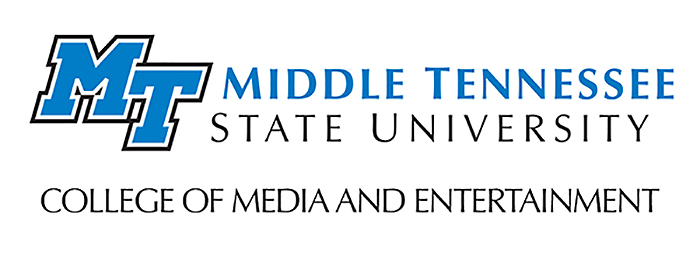 Department of Media Arts and Department of Recording Industry students in the College of Media and Entertainment joined their peers from the Department of Theatre and Dance in the College of Liberal Arts March 24 in the Student Union ballroom, combining their skills in live video production, video wall design and installations, audio production and stage lighting to create a “Signature Events” experience.
Department of Media Arts and Department of Recording Industry students in the College of Media and Entertainment joined their peers from the Department of Theatre and Dance in the College of Liberal Arts March 24 in the Student Union ballroom, combining their skills in live video production, video wall design and installations, audio production and stage lighting to create a “Signature Events” experience.
 The concert, which featured “American Idol” semifinalist and Knoxville, Tennessee, singer-songwriter Briston Maroney and fellow Knoxvillian and MTSU music business major Cece Coakley as the opening act, gave nearly 50 students another successful opportunity to apply their skills outside the classroom.
The concert, which featured “American Idol” semifinalist and Knoxville, Tennessee, singer-songwriter Briston Maroney and fellow Knoxvillian and MTSU music business major Cece Coakley as the opening act, gave nearly 50 students another successful opportunity to apply their skills outside the classroom.
“It was a great partnership with a bunch of different areas to make something happen, and … that’s really what it’s all about,” said Richard Kershaw, director of MTSU’s Student Programming and Raider Entertainment Office, known as SPARE.
“The whole process is about doing stuff for our students — for the students who came for the show who were really craving having something in-person but were still scared, and rightly so, about COVID, we had to try and make it so they felt safe enough to be there and enjoy it, and for the students watching online, and for the students who were working. Their gaining real-life experience is invaluable.”
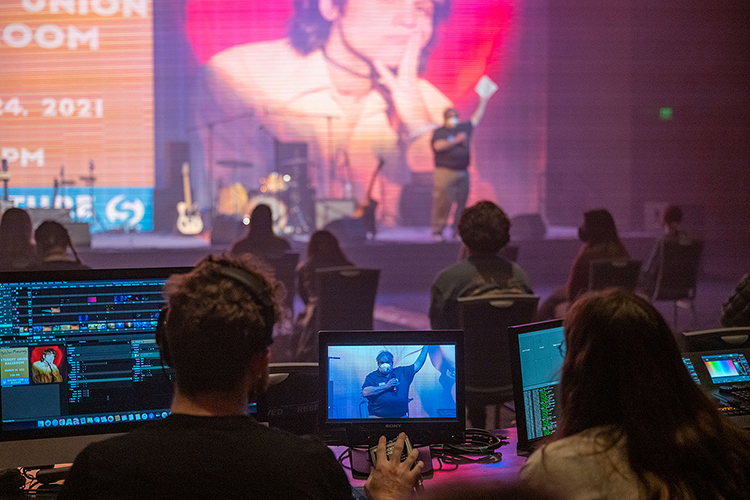
Department of Media Arts students in MTSU’s media technology course monitor the video wall Wednesday, March 24, while Richard Kershaw, director of MTSU’s Student Programming and Raider Entertainment Office, is shown onscreen emceeing the Briston Maroney “Signature Events” concert in the Student Union ballroom. Nearly 50 students from two different colleges — and three departments — collaborated to present MTSU’s first in-person, large-scale “Signature Event” since 2019. (MTSU photo by Cat Curtis Murphy)
SPARE works with representatives from the Student Government Association on the Signature Events Committee each year to expand MTSU students’ entertainment options on campus.
MTSU President Sidney A. McPhee agreed earlier this month to allow extracurricular gatherings for a maximum of 50 students. They must continue to follow the university’s health safety protocols, wear masks and stay at least six feet apart.
Once the students set up equipment and prepared the stage and the ballroom the day before the March 24 concert, the pandemic protocols limited the crews to only two or three members each inside the room for the event itself.
‘A different experience for them’
Recording industry faculty member Frank Baird, an assistant professor of audio production and the director of MTSU’s new Chris Young Cafe, supervised students from his sound reinforcement class as they perfected the performances’ sound during the 90-minute-plus show.
Those students have been working this spring inside the cafe, preparing for live events like this one after their success at the January opening of the new training and performance venue.
“I was watching him teach the kids, and it’s a different experience for them,” Kershaw said of his MTSU colleague. “We were talking about it, and Frank said, ‘I get to teach them in a different way when they’re … physically doing the work, physically loading it in, adjusting lights and sound. The sound, they’re hearing it in a real, live situation with people; it’s a very different way to teach.’”

Sam Hopewell, left, a senior audio production major from Rockford, Illinois, works on the mixing board while Department of Recording Industry professor Frank Baird gestures to another crew member on stage during setup Wednesday, March 24, for the Briston Maroney concert in MTSU’s Student Union ballroom. Hopewell, whose minor is in theatre, was one of nearly 50 students from two different colleges — and three departments — who collaborated to present MTSU’s first in-person, large-scale “Signature Event” since 2019. (MTSU photo by Andy Heidt)
Outside the Student Union, students from media arts professor Robert Gordon’s advanced multi-camera TV production course worked inside the university’s $1.7 million Mobile Production Lab, aka “The Truck,” to capture the concert for livestreaming.
Gordon’s students spent most of their waking hours last fall in the truck or inside with the action, providing high-definition coverage of football and basketball games, multiple Department of Theatre and Dance productions and 2020 election night returns, as well as working outdoors at MTSU’s fall 2020 in-person graduation ceremonies.
This spring’s schedule has included women’s basketball, volleyball and soccer games. They’ll also cover their college’s Wall of Fame ceremony later this semester.
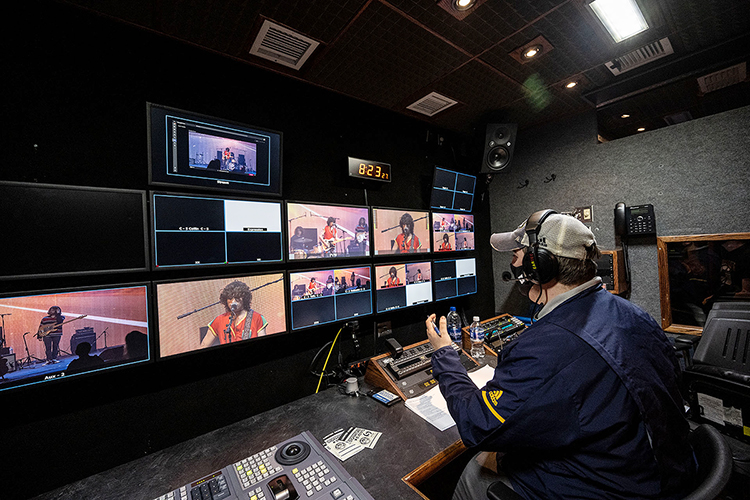
MTSU junior John Blanton of Brentwood, Tennessee, a video and film production major, directs the coverage of at the Briston Maroney concert in the Student Union ballroom Wednesday, March 24, from the university’s $1.7 million Mobile Production Lab, aka “The Truck.” Blanton was one of nearly 50 students from two different colleges — and three departments — who collaborated to present MTSU’s first in-person, large-scale “Signature Event” since 2019. (MTSU photo by Cat Curtis Murphy)
Students in the media technology course taught by Mike Forbes, Media Arts’ assistant director for technical systems, designed and built a video wall 40 feet wide and 18 feet high, working with Maroney’s management to personalize a seamless backdrop for the performances.
The La Vergne, Tennessee, branch of international entertainment technology company PRG donated the LED tiles for that video wall to the Department of Media Arts. Even as it nearly reached the ballroom’s 20-foot ceiling, the huge LED wall used only 180 of PRG’s 574 donated panels, Forbes said.
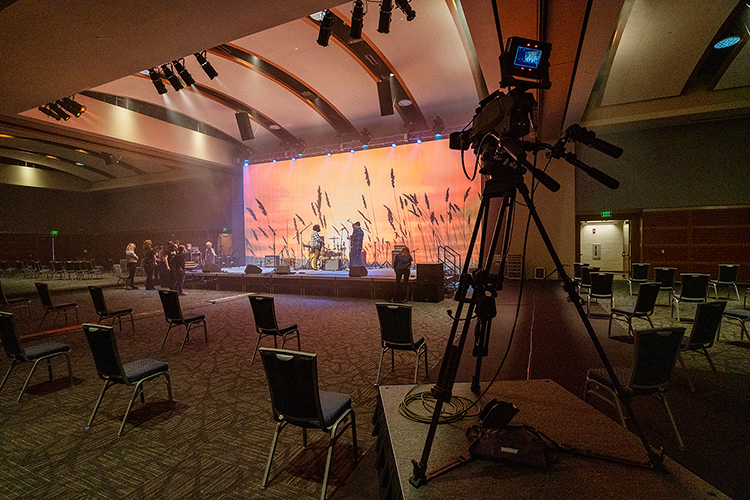
Students from three departments across MTSU’s College of Media and Entertainment and the College of Liberal Arts work together in the Student Union ballroom Wednesday, March 24, to set up for the Briston Maroney concert. Department of Media Arts students designed and built the 40-foot-by-18-foot video wall onstage and filmed the socially distanced show to stream live, while Department of Recording Industry students perfected the sound and Department of Theatre and Dance students provided the lighting expertise. (MTSU photo by Andy Heidt)
“It was a massive wall, and it was just great. The band seemed thrilled about the set-up,” said Kershaw, who’s been coordinating special events like this show for MTSU students since 2004, drawing artists like Ludacris, Icona Pop, Young the Giant and Widespread Panic.
“There’s no way … if we had to try to HIRE a company like that to do all that? Oh my gosh. It would be crazy expensive. People may not expect to see the kind of large-scale setup like we had out there, run by a professional-caliber student crew.”
‘Win-win for all of us’
Billy Pittard, chair of the Department of Media Arts, noted that bringing people with different skills together to collaborate on projects like this can benefit participants on both sides of the camera, microphone and screen.
“Interdisciplinary collaboration is essential in the media and entertainment industry, and this event was a great example of that,” Pittard said. “This kind of hands-on collaboration helps students launch professional careers after graduation.
“We should also recognize that the live broadcast also made it possible for a much wider audience to enjoy this event.”

Gabriel Stanley, a senior audio production major from Speedwell, Tennessee, checks a microphone on stage during setup Wednesday, March 24, for the Briston Maroney concert in MTSU’s Student Union ballroom. Stanley was one of nearly 50 students from two different colleges — and three departments — who collaborated to present MTSU’s first in-person, large-scale “Signature Event” since 2019. Department of Media Arts students designed and built the 40-foot-by-18-foot video wall on stage behind Stanley, whose major is in the Department of Recording Industry. (MTSU photo by Andy Heidt)
Along with the live and recorded theatre and dance performances Gordon and his students captured, for example, Forbes and his students also collaborated with the theatre department to create a striking Broadway-caliber video wall for its 2018 musical “Joseph and the Amazing Technicolor Dreamcoat.”
Justin Reed, then the theatre department’s production manager and now director of student unions for MTSU, was the instigator for this spring’s interdisciplinary teamwork. He suggested it to Kershaw and guided the student crew who created professional-level lighting for the concert.
Dustin Cunningham, technical services manager for MTSU Student Unions, put all the teams together and provided the streaming expertise to showcase their work.
“I’ve known since my days in the theatre department that these AMAZING technical programs (in both colleges) don’t have the resources, financially, to bring in these big artists, so partnering them with the programming arm of the university, like the (Student) Union, just seemed to make sense,” Reed said.
“I think these students are getting a better experience and a look into what the industry is like, and so far it seems like a win-win for all of us involved.”
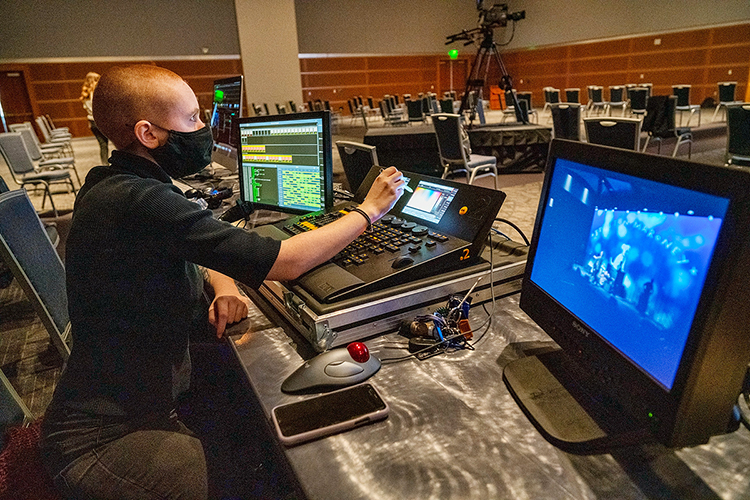
Erin Featherston, a senior theater major from Powell, Tennessee, makes adjustments to the lighting during setup Wednesday, March 24, for the Briston Maroney concert in MTSU’s Student Union ballroom. Featherston, whose minor is in entertainment technology, was one of nearly 50 students from two different colleges — and three departments — who collaborated to present MTSU’s first in-person, large-scale “Signature Event” since 2019. (MTSU photo by Andy Heidt)
For more information on MTSU’s Department of Media Arts, visit www.mtsu.edu/mediaarts. To learn about the Department of Recording Industry, visit www.mtsu.edu/recording-industry.
The Department of Theatre and Dance’s website is www.mtsu.edu/theatreanddance, and the MTSU Student Unions home page is www.mtsu.edu/mtunions.
MTSU’s Student Programming and Raider Entertainment website is www.mtsu.edu/spare.
To learn more about the College of Media and Entertainment and its programs, visit www.mtsu.edu/media. For more information on the College of Liberal Arts at MTSU, visit www.mtsu.edu/liberalarts.
— Gina E. Fann (gina.fann@mtsu.edu)

MTSU senior video and film production majors Nathaniel Muncie, left, of Johnson City, Tennessee, and Brea Robbins of Cookeville, Tennessee, focus on the stage, featuring a student-constructed 40-foot-by-18-foot video wall, on Wednesday, March 24, between acts at the Briston Maroney concert in the Student Union ballroom. The Department of Media Arts students in MTSU’s advanced multi-camera TV production course were among nearly 50 students from two different colleges — and three departments — who collaborated to present MTSU’s first in-person, large-scale “Signature Event” since 2019. (MTSU photo by Cat Curtis Murphy)

Mike Forbes, left, assistant director for technical systems for MTSU’s Department of Media Arts, talks with Department of Recording Industry professor Frank Baird as their students prepare Wednesday, March 24, for the Briston Maroney concert in the university’s Student Union ballroom. Forbes’ students designed and built the 40-foot-by-18-foot video wall onstage and Baird’s students perfected the audio for the socially distanced show. Nearly 50 students from two different colleges — and three departments — collaborated to present MTSU’s first in-person, large-scale “Signature Event” since 2019. (MTSU photo by Andy Heidt)
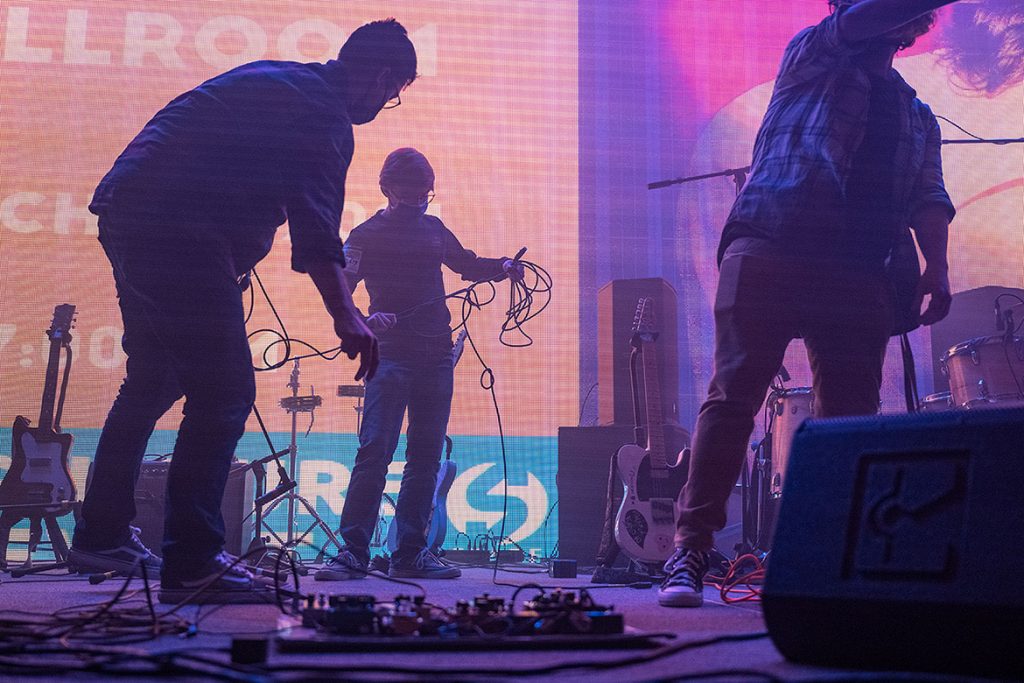
Department of Recording Industry students in MTSU’s sound reinforcement courses adjust cables and prepare audio setups on stage Wednesday, March 24, between sets at the Cece Coakley and Briston Maroney concert in MTSU’s Student Union ballroom. Nearly 50 students from two different colleges — and three departments — collaborated to present MTSU’s first in-person, large-scale “Signature Event” since 2019. (MTSU photo by Cat Curtis Murphy)

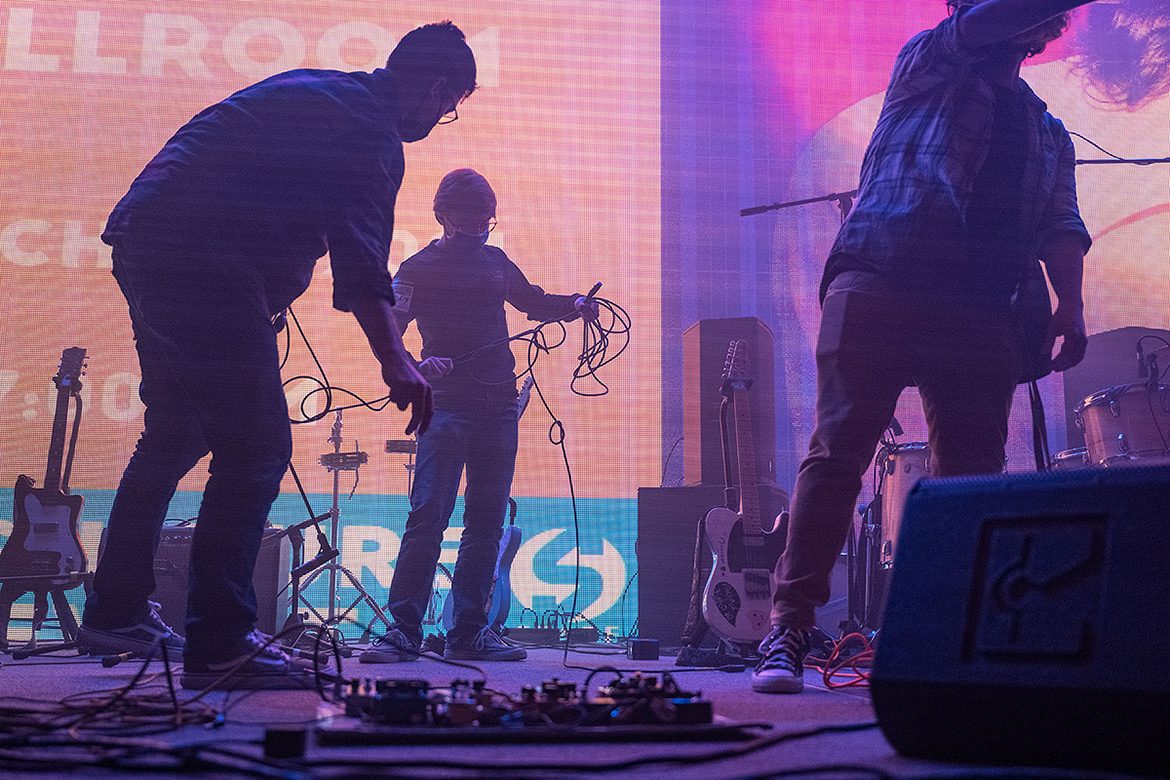
COMMENTS ARE OFF THIS POST